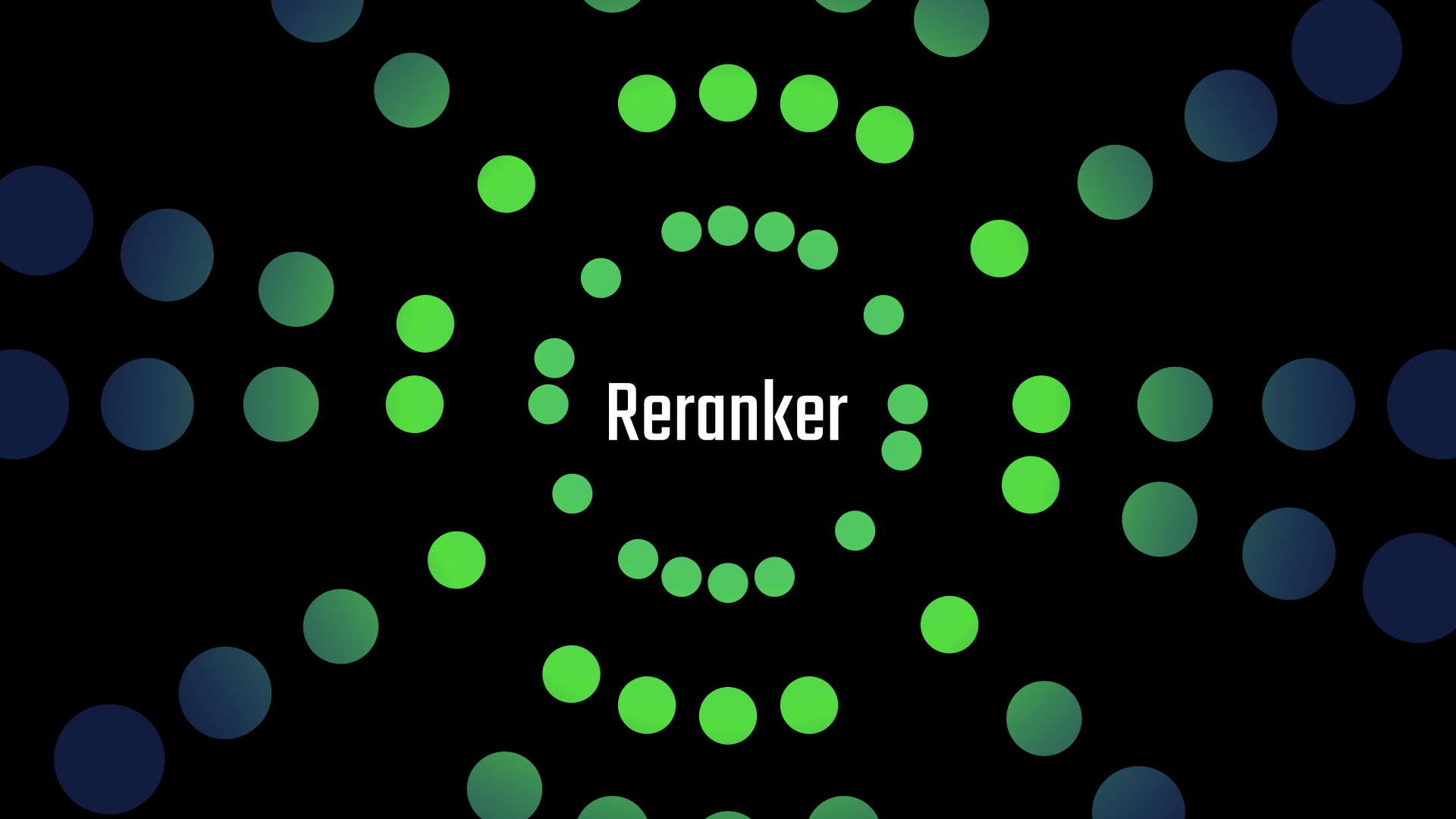Maximizing Search Relevance and RAG Accuracy with Jina Reranker
Boost your search and RAG accuracy with Jina Reranker. Our new model improves the accuracy and relevance by 20% over simple vector search. Try it now for free!

Text embeddings, known for their semantic representation capabilities, along with fast vector retrieval, are today's cornerstone in document search within vast datasets. However, the challenge often lies in filtering through these retrieved documents to accurately align with the user's search intent, a task that goes beyond the capabilities of simple cosine similarity measures.
Today, we're thrilled to announce Jina Reranker (jina-reranker-v1-base-en), a cutting-edge neural reranking model designed to tackle this critical issue of relevancy. Jina Reranker enhances your search and RAG (Retrieval-Augmented Generation) system by reordering retrieved documents in a manner that deeply and contextually understands the search query terms. Our evaluations demonstrated remarkable improvements for search systems employing the Jina Reranker with +8% in hit rate and +33% in mean reciprocal rank!

What is a Reranker?
Understanding the concept of a reranker often leads us to question the necessity of re-ranking mechanisms in search (ranking) systems. Common questions are, "Why do we need a reranker?" and "Isn't ranking documents by cosine similarity between the query and document embeddings enough already?" To address these questions, let's first revisit the single embedding cosine similarity approach and its limitations.
Cosine similarity quantifies the similarity between two documents by measuring the cosine of the angle between their embedding vectors. This metric is valued for its simplicity and has been used in many vector databases as the default way of retrieval. However, this approach, commonly termed as a representation-based approach, tends to oversimplify interaction between query and documents. Specifically, it struggles with capturing the nuanced interaction at the sub-document level and sub-query level, often missing the full depth of user intent and the fine details of document relevance.

This is where rerankers come into play. Utilizing deep neural networks, rerankers delve deeper into the interactions between the query and the shortlisted documents. They move beyond basic document-level embeddings to embrace token-level interactions that occur within the query, within the document, and across the query-document boundary. Although this method is more computationally intensive compared to simple cosine similarity, it enables a nuanced comparison that incorporates context, semantic meaning, and the intent behind the query, substantially improving the relevancy of search results.
| Vector Search via Cosine Similarity | Reranker | |
|---|---|---|
| Interaction Level | Document-level embeddings | Token-level interactions |
| Computational Demand | Low | High |
| Most computation happens at | Offline, i.e. indexing time | Online, i.e. query time |
| Result | Broad but superficial matching | Highly relevant and precise matching |
| Strengths | - Fast and efficient - Simple implementation |
- Deep contextual understanding - Advanced semantic analysis |
| Limitations | - Limited by lack of depth and context - May miss nuances of user intent |
- Computationally intensive - Requires more sophisticated models |
| Best For | Provides a quick, efficient first pass | Adds depth, enhancing accuracy and relevance of final search results |
In summary, reranker is a critical component in the search pipeline. A high-quality search system typically begins with an embedding-based vector retrieval step, which is then refined by a reranker model. This two-step approach leverages the strengths of both models, ensuring the delivery of precise, high-quality information that aligns seamlessly with the user's needs.

Get Started with Jina Reranker
To start using Jina Reranker, head to our Reranker page to get YOUR_API_KEY. You can adapt the example cURL snippet below by changing the query or adding more documents:
curl -X 'POST' \
'https://api.jina.ai/v1/rerank' \
-H 'accept: application/json' \
-H 'Authorization: Bearer YOUR_API_KEY' \
-H 'Content-Type: application/json' \
-d '{
"model": "jina-reranker-v1-base-en",
"query": "Organic skincare products for sensitive skin",
"documents": [
"Eco-friendly kitchenware for modern homes",
"Biodegradable cleaning supplies for eco-conscious consumers",
"Organic cotton baby clothes for sensitive skin",
"Natural organic skincare range for sensitive skin",
"Tech gadgets for smart homes: 2024 edition",
"Sustainable gardening tools and compost solutions",
"Sensitive skin-friendly facial cleansers and toners",
"Organic food wraps and storage solutions",
"All-natural pet food for dogs with allergies",
"Yoga mats made from recycled materials"
],
"top_n": 3
}'
In this example, the documents range from home goods to tech gadgets, clothing, and even pet food, showcasing a wide spectrum of products one might find on an e-commerce site. This diversity requires the reranker to effectively identify and prioritize items most relevant to the query about "Organic skincare products for sensitive skin," despite the presence of other organic, eco-friendly, or sensitive skin-related products in different categories. The response is a JSON object as follows:
{
"model": "jina-reranker-v1-base-en",
"usage": {
"total_tokens": 38,
"prompt_tokens": 38
},
"results": [
{
"index": 3,
"document": {
"text": "Natural organic skincare range for sensitive skin"
},
"relevance_score": 0.8292155861854553
},
{
"index": 2,
"document": {
"text": "Organic cotton baby clothes for sensitive skin"
},
"relevance_score": 0.14426936209201813
},
{
"index": 6,
"document": {
"text": "Sensitive skin-friendly facial cleansers and toners"
},
"relevance_score": 0.13857832551002502
}
]
}Top Performance of Jina Reranker
We evaluated Jina Reranker on four key benchmarks to ensure top-tier performance and search relevance. Higher performance in these benchmarks directly translates to better precision, relevance, and contextual understanding in search and retrieval applications.
For comparison, we included three other leading rerankers by BGE (BAAI), BCE (Netease Youdao), and Cohere in the benchmark. As shown by the results below, Jina Reranker holds the highest average score in all relevant categories for reranking, making it a clear leader among its peers.
Benchmark 1: LlamaIndex RAG
A benchmark study performed by LlamaIndex (which we reproduced), evaluated a combination of different embedding and reranking models in RAG tasks. This combines two scores - Hit-rate (how likely it is that a relevant document is retrieved by an embedding model), and Mean Reciprocal Rank (MRR - how high the most relevant document is ranked by the reranker model).
| No Reranker | jina-reranker | bge-reranker-base | bce-reranker-base_v1 | cohere-reranker | ||||||
|---|---|---|---|---|---|---|---|---|---|---|
| Embedding model | Hit Rate | MRR | Hit Rate | MRR | Hit Rate | MRR | Hit Rate | MRR | Hit Rate | MRR |
| jina-embeddings-v2-base-en | 0.8053 | 0.5156 | 0.8737 | 0.7229 | 0.8368 | 0.6568 | 0.8737 | 0.7007 | 0.8842 | 0.7008 |
| bge-base-en-v1.5 | 0.7842 | 0.5183 | 0.8368 | 0.6895 | 0.8158 | 0.6586 | 0.8316 | 0.6843 | 0.8368 | 0.6739 |
| bce-embedding-base_v1 | 0.8526 | 0.5988 | 0.8895 | 0.7346 | 0.8684 | 0.6927 | 0.9157 | 0.7379 | 0.9158 | 0.7296 |
| CohereV3-en | 0.7211 | 0.4900 | 0.8211 | 0.6894 | 0.8000 | 0.6285 | 0.8263 | 0.6855 | 0.8316 | 0.6710 |
| Average | 0.7908 | 0.5307 | 0.8553 | 0.7091 | 0.8303 | 0.6592 | 0.8618 | 0.7021 | 0.8671 | 0.6938 |
Substantial Improvement Over Simple Cosine Similarity
The improvement Jina Reranker brings to both Hit Rate and Mean Reciprocal Rank (MRR) is significant. On average, the introduction of Jina Reranker elevates the Hit Rate from 0.7908 to 0.8553 (+7.9%), and the MRR from 0.5307 to 0.7091 (+33.7%). This showcases the reranker’s ability to enhance the precision and relevance of search results dramatically, ensuring that users are more likely to find what they're searching for with higher accuracy.
Embeddings Agnosticism
Jina Reranker's performance across different embedding models further illustrates its model-agnostic nature. Whether paired with jina-embeddings-v2-base-en, bge-base-en-v1.5, bce-embedding-base_v1, or CohereV3-en, Jina Reranker consistently improves the Hit Rate and MRR. This versatility makes it an invaluable tool for a wide range of applications, affirming its adaptability to different underlying technologies and use cases.
Benchmark 2: BEIR
BIER (Benchmarking IR) assesses a model's retrieval effectiveness, including relevance and NDCG. A higher BIER score correlates to more accurate matches and search result rankings.
| Dataset | jina-reranker | bge-reranker-base | bce-reranker-base-v1 | cohere-rerank-english-v2.0 |
|---|---|---|---|---|
| NQ | 0.5951 | 0.5457 | 0.5186 | 0.6004 |
| HotpotQA | 0.7447 | 0.7766 | 0.7392 | 0.7202 |
| FiQA-2018 | 0.3981 | 0.3228 | 0.3262 | 0.4387 |
| CQADupstack | 0.4077 | 0.3516 | 0.3594 | 0.3829 |
| Quora | 0.8792 | 0.7001 | 0.8390 | 0.6433 |
| FEVER | 0.8707 | 0.8961 | 0.7203 | 0.8265 |
| Climate-FEVER | 0.2570 | 0.3399 | 0.2171 | 0.2038 |
| TREC-COVID | 0.8523 | 0.7121 | 0.7364 | 0.8419 |
| NFCorpus | 0.3809 | 0.3308 | 0.3534 | 0.3673 |
| ArguAna | 0.5938 | 0.2620 | 0.3856 | 0.3040 |
| Touche-2020 | 0.3065 | 0.2965 | 0.2533 | 0.3052 |
| DBPedia | 0.4387 | 0.4196 | 0.4069 | 0.4236 |
| SciFact | 0.7549 | 0.7104 | 0.7021 | 0.7379 |
| SCIDOCS | 0.1983 | 0.1540 | 0.1802 | 0.1813 |
| MSMarco | 0.7042 | 0.7303 | 0.7155 | 0.7350 |
| Average | 0.5588 | 0.5032 | 0.4969 | 0.5141 |
Benchmark 3: MTEB
The MTEB (Multilingual Text Embedding Benchmark), on the whole, tests a model’s abilities in text embeddings, including clustering, classification, retrieval, and other metrics. However, for our comparison, we only used the MTEB’s Reranking tasks.
| Dataset | jina-reranker | bge-reranker-base | bce-reranker-base-v1 | cohere-rerank-english-v2.0 |
|---|---|---|---|---|
| AskUbuntuDupQuestions | 0.5793 | 0.5471 | 0.5654 | 0.5536 |
| SciDocsRR | 0.8056 | 0.6741 | 0.7578 | 0.6728 |
| StackOverflowDupQuestions | 0.4850 | 0.3764 | 0.4287 | 0.4414 |
| Average | 0.6233 | 0.5325 | 0.5840 | 0.5559 |
Benchmark 4: LoCo
Through the LoCo benchmark, we measured a model's understanding of local coherence and context, together with query-specific ranking. A LoCo higher score reflects a better ability to identify and prioritize relevant information.
| Dataset | jina-reranker | bge-reranker-base | bce-reranker-base-v1 | cohere-rerank-english-v2.0 |
|---|---|---|---|---|
| qasper_None_abstract | 0.996 | 0.774 | 0.989 | 0.919 |
| qasper_None_title | 0.980 | 0.883 | 0.971 | 0.983 |
| scrolls_gov_report_output | 0.962 | 0.574 | 0.922 | 0.659 |
| scrolls_qmsum_output | 0.466 | 0.549 | 0.449 | 0.444 |
| scrolls_summ_screen_fd_output | 0.962 | 0.629 | 0.920 | 0.905 |
| Average | 0.873 | 0.682 | 0.850 | 0.782 |
Jina Reranker Model Highlights
The Jina Reranker distinguishes itself as a leader in the reranking domain, outperforming key competitors from Cohere, BGE, and BCE, as illustrated in the previous analysis. Its embedding-agnostic nature and unmatched efficacy underscore its premier status in the industry. Furthermore, Jina Reranker boasts notable features that set it apart:
Long Context Length
Jina Reranker stands out from other reranking solutions by accommodating long context lengths. It is capable of handling queries up to 512 tokens and documents as large as 8192 tokens. Furthermore, the model is designed to process up to 2048 candidate documents for each query.
| Time cost of rerank(query=1, docs=100) in ms | #TokensPerDocument | ||||
|---|---|---|---|---|---|
| #QueryTokens | 256 | 512 | 1024 | 2048 | 4096 |
| 64 | 156 | 323 | 1366 | 2107 | 3571 |
| 128 | 194 | 369 | 1377 | 2123 | 3598 |
| 256 | 273 | 475 | 1397 | 2155 | 4299 |
| 512 | 468 | 1385 | 2114 | 3536 | 7068 |
Enhancing Accuracy with RAG Integration
Retrieval Augmented Generation (RAG) significantly enhances the precision of responses from large language models (LLMs) by incorporating additional, context-specific information—such as a company's internal database—into the query process. This method ensures the LLM's responses are firmly based on provided contextual data. The integration of rerankers with RAG within an information retrieval pipeline paves the way for the development of high-performance applications capable of delivering precise information retrieval across a vast array of domains.
Consider, for example, the scenario where you're planning to cook a special meal using specific ingredients favored by your guests. To simplify this task, you decide to employ a chatbot that suggests recipes based on renowned cookbooks. Initially, without a reranker, your input might look something like this:
Context information is below.
---------------------
{Madhur_Jaffrey_An_Invitation_To_Indian_Cooking}
{Julia_Child_Mastering_The_Art_Of_French_Cooking}
{Jiro_Ono_Sushi_Estetica_E_Tecnica}
---------------------
Given the context information and no prior knowledge, answer the query.
Query: Create a recipe using the ingredients below.
---------------------
Salmon
Asparagus
Potatoes
---------------------
Incorporating a reranker model, however, allows for a nuanced understanding of document relevance, enhancing the LLM's context with information about the relative importance of each cookbook. The refined input, highlighting the ranked relevance of the context to the query, might then appear as follows:
Context information is below.
Note that the context is ranked from most to least relevant to the query.
---------------------
{Julia_Child_Mastering_The_Art_Of_French_Cooking}
{Jiro_Ono_Sushi_Estetica_E_Tecnica}
{Madhur_Jaffrey_An_Invitation_To_Indian_Cooking}
---------------------
Given the context information and no prior knowledge, answer the query.
Query: Create a recipe using the ingredients below.
---------------------
Salmon
Asparagus
Potatoes
---------------------
This additional layer of insight into the cookbooks' relevance to the given ingredients makes it evident that the optimal recipe likely falls within French cuisine, steering the chatbot's suggestion in a direction that best matches the ingredients' culinary context. Without reranking, a suggestion based on sushi could have been equally plausible given the prominence of salmon, yet it would have led to a markedly different dining experience.
Moreover, by determining the number of documents to be considered in the ranking process, users can fine-tune the operation's precision and computational demands to suit their specific requirements, further illustrating the reranker's versatility and effectiveness.
Affordable API pricing
Jina Reranker API comes with identical pricing to our embedding API (including 1 million free trial), such as jina-embeddings-v2-base-en , based on the total number of tokens, in queries and documents. Token quotas can be bought on our Embeddings/Reranker API page. The API secret and token quotas can be used for both reranker and embedding APIs.
Coming Soon to AWS Marketplace
Expanding our reach, Jina Reranker will not only be accessible via our API but is also set to debut on the AWS SageMaker Marketplace for seamless private cloud deployment. This upcoming availability aims to offer enhanced data protection and application security within the familiar confines of your AWS cloud subscription.
We highly value your insights and experiences with Jina Reranker. Talk to us on our Discord channel to share your feedback and stay up-to-date with our latest models. Your input is crucial as we continue to refine our technologies and contribute to a more dynamic and inclusive search AI ecosystem.

